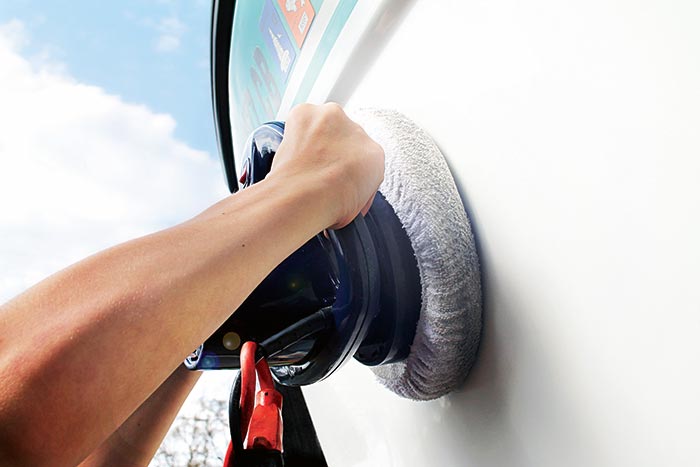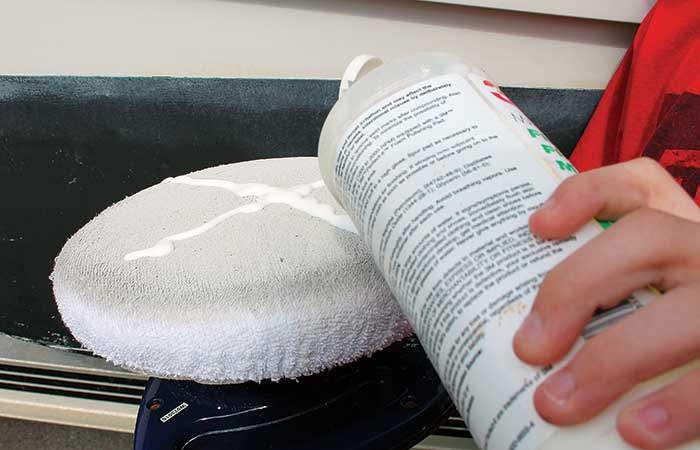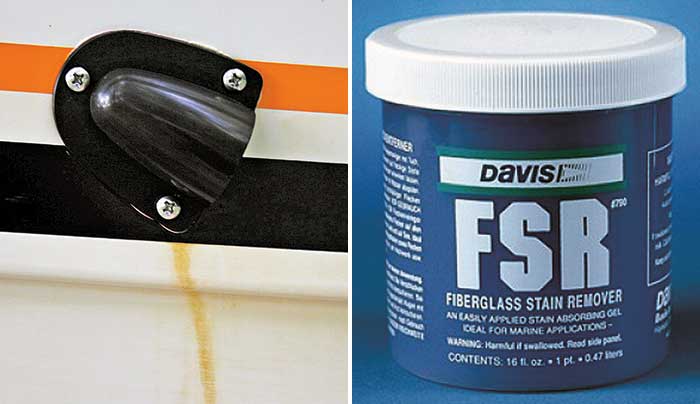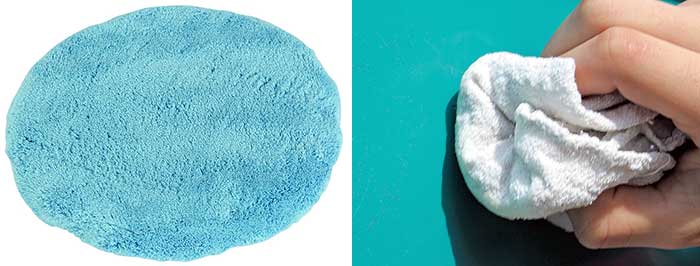Advertisement
Seal out the oncoming winter with rubbing, buffing, waxing, and polishing, but don't forget the elbow grease.

Hold the buffer flat against the hull sides, and apply pressure evenly.
Keeping gelcoat properly maintained isn't just a matter of vanity, it's also a matter of protecting your boat's fiberglass. Now that we have that out of the way, let's get real — you do want to dazzle your slip neighbors with the mirror-like hull sides on Mom's Mink, don't you? You're far more likely to be able to raise a good shine come spring if you remove the season's stains now and protect the fiberglass from the ravages of winter with a couple of good coats of wax. Luckily, keeping your boat in tip-top shape is a lot easier than it was in the old days when wooden vessels called for scraping, sanding, and painting for hours on end. But don't get too smug. There's still a lot of work in your future, so let's get started.
Step 1: Remove Oxidation
For the purposes of this article, we'll assume you're starting with gelcoat that's slightly oxidized. If it's extremely oxidized, you may need to call in a pro. If your gelcoat doesn't show any signs of oxidation (yellowing and/or a chalky, dull appearance), skip to Step 2. Oxidation occurs naturally, as exposure to sun and weather break down the gelcoat's surface and turn it chalky and pitted. If your boat is more than a couple of years old and hasn't been meticulously maintained, chances are there's some level of oxidation. The more there is, the tougher this step will be.

Make an "X" on your buffer bonnet with the liquid.
You need to hit every inch of the fiberglass with a good oxidation remover. As a rule of thumb, it's best to use the least abrasive oxidation remover possible, so you don't grind away lots of gelcoat. How will you pick which one is right? Test a few different products on a small section of the gelcoat to find the least abrasive product that still gets the job done. If you try to deoxidize the entire boat by hand, you'll blow out your elbows; an orbital buffer is a must-have tool for this task.
Fit the buffer with a terry cloth bonnet, and pour a big "X" onto it with the oxidation remover. Then hold the buffer gently against the hull side with even pressure, and hit the power button.
Tip
If you accidentally pour too much oxidation remover onto the buffer bonnet, move down three or four feet and blob it onto the hull side. That way you can make use of it as you work your way down the boat.
Warning: If you hit the power button before the buffer is sitting flat against the hull, it'll spray oxidation remover in every direction.
Once the buffer is running, sweep it back and forth across the hull, going over the same area three or four times and being sure not to leave any gaps in your coverage. Never hold the buffer still, or it can "burn" a divot in the gelcoat.
You've hit the entire hull? Now look carefully for spots the buffer missed because there are always a few (under the rub rail, transom corners, and around thru-hull fittings, for example) and do them by hand. Then put a new bonnet on the buffer, and use it to rub off the oxidation remover. If the oxidation was severe, or if the remover you chose was too weak, you may have to repeat this step.

Acid-based cleaners are necessary to get out tough stains like rust streaks.
Step 2: Eliminate Stains
Once the oxidation is gone, there's a good chance you'll see a few stains. Let's get rid of them. Most can be attacked with rubbing compound and a rag, but toughies like rust streaks will require the use of an acid-based cleaner. These are often marked "fiberglass stain remover," but read the active ingredients to be sure some sort of acid is listed. Also be sure to limit their usage to where they're absolutely necessary, and follow the instructions on the bottle; these cleaners can give off harmful fumes, burn your skin, and damage the gelcoat if you don't thoroughly rinse them away after use. Be careful that you don't rinse them into the water.
Step 3: Bring Out The Shine
Now we can polish the hull sides into tip-top shape. There are many good polishing products from which to choose, but this is not the time to opt for a combination polish/wax. That stuff is great for midseason touch-ups, but not for sealing out winter weather. Go for a dedicated polish such as Starbrite Premium Marine Polish. Apply the polish as you applied the oxidation remover, sweeping the buffer back and forth across the fiberglass until the entire boat has been covered. Let it dry, and then remove it. Whew! You've probably worked up a sweat by now, but we're just getting started; you need to do the entire boat a second time, because one of the keys to making a boat shine like the sun is to polish it twice.
Tip
Come spring, you'll get an even better shine if you use one of those expensive microfiber polishing buffer bonnets for this stage, instead of the regular terry cloth variety.
Step 4: Seal In The Shine
We'll bet the glare coming off Mom's Mink is downright blinding right about now, but if you stop working, the gelcoat's finish will go back to being dull in a matter of days. You need to seal that shine in, and wax is the key ingredient. For this step, choose a paste wax that's based on bee's wax, NOT carnauba wax, which does create a better shine but also wears away faster. Again, you need to give the boat two thorough coatings of the paste wax, and unfortunately, this stuff gets applied by hand. Now for the coup de grâce: a coating of that shiny carnauba stuff. Apply it lightly and gently, so you don't rub away any of the paste wax. Then clean it off with a final pass of the microfiber buffer bonnet.

Microfiber bonnets cost more than terry cloth, but for final polishing, they'll make your boat shine brighter. Apply the paste wax by hand — this may take a while!
That was a lot of work, but a lot less than scraping, sanding, and painting. In the spring, you should be able to get away with a quick polish and then sealing in the shine. You can keep your boat looking red-hot all summer by washing it down with a wash-n-wax boat soap that contains a dose of carnauba. If you're a perfectionist, renew the shine by giving the gelcoat another carnauba wax job every other week. And don't look directly at your boat's gelcoat without wearing sunglasses, or you might burn out a retina. If not, then it's time to (sigh) go back to Step 1.
